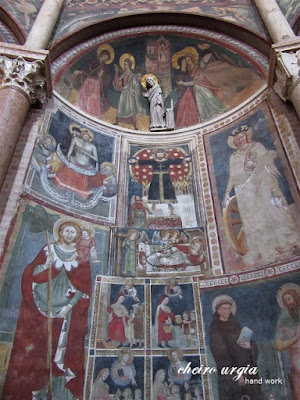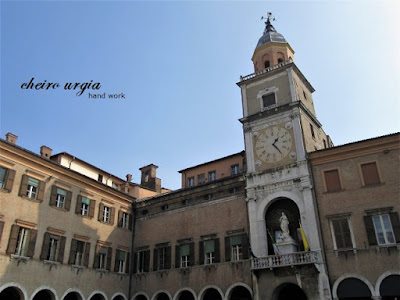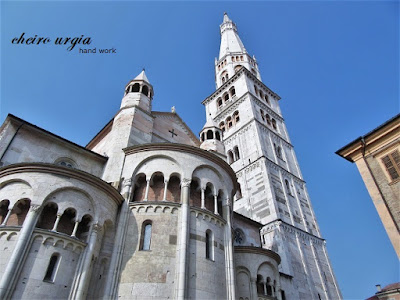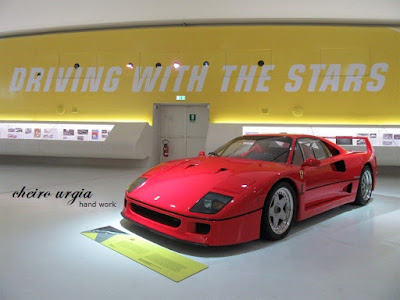And since much was on the to-do list, we'd start quite early in the morning with a walk under the impressive pillars of Palazzo della Pilotta, straight towards the historic centre of Parma. The Palazzo itself is home to several museums, the National Gallery, the Bibliotheca Palatina, as well as the famous wooden Teatro Farnese. Unfortunately, we wouldn't have time for any of this, but after a couple of minutes already...
... two of the city's major attractions were standing tall, overlooking the streets of Parma that were slowly coming to life. Firstly, the magnificent Baptistery of Parma, which will catch your eye with its octagonal shape and countless decorations on the outside...
... as well as a stunningly painted interior that is built in the form of arches, which run together in an equally fascinating cupola.
Given the marvels depicted on the walls, the huge octagonal font which forms the actual center of the baptistery seems to be almost un-noticed.
And as if one marvel wasn't enough, guarded by lions made by a sculptor who has probably never seen lions in his whole life...
... the cathedral of Parma was ready to take our breaths away.
It's warm golden/brown-ish shades glow, combined with paintings that seem to cover every bit of the basilica, must have caused quite a few stiff necks over the centuries.
After a bit time for individual discoveries in the now vibrant city of Parma...
... it was time to move on to our next stop for the day: Modena. Wandering past the Palazzo Ducale and through the lovely, colourful streets of the city center...
... we'd soon find ourselves on the city's main square, embraced by the city hall as well as another beautiful cathedral. With its white tower overlooking the city...
... its side covered in names of executed Italian partisans and members of resistance...
... and lions that in fact do resemble lions...
... the interior of this duomo might be modest at first (especially in comparison with the Parma cathedral), however, it is surprisingly bright, has super friendly staff and many treasures scattered all over the place.
Most notably, a colourful marble relief which depicts the Passion of Christ alongside the four Evangelists, created by an anonymous artist to decorate the bridge-like pier in the front part of the church, which floats above the crypt.
At the same time, the rather unusual architectural solution also creates a physical barrier between the spacious naves and the very byzantine-looking sanctuary.
On the side note, who knew there is a holy man that genuinely looks like the patron saint of people who pull children by their hair?
But the region of Modena is home to many more famous personalities. Just outside the city center lies a museum dedicated to one of the most well known Italian products: the sports car with the black horse, closely connected with its founder Enzo Ferrari.
While the former workshop of his father Alfredo nowadays tells the story of the company's beginnings and different Ferrari engines...
... one will also have the chance to come face to face with F1 racing cars, which turn out to be rather claustrophobic up close.
I don't think I'd feel comfortable after squeezing myself behind the wheel, and I can absolutely not imagine a grown-up man to feel comfortable either. Unless of course, F1 drivers are really small and thin men?
Across the old factory building, a futuristic glass museum presents other aspects of the Ferrari story: in a huge exhibition area without a single shore to support the roof, different models of its iconic cars can be seen...... from the early times of Ferrari...
... to more recent ones. However, even here I just couldn't seem to find the idea of "having a Ferrari" appealing. Of course, the idea of a shiny super sports car in the garage might be appealing to many, but just like their F1 versions they somehow looked small and uncomfortable to me, as well as way too low and lacking proper storage space.
Which by no means translates in a bad museum - this, too, might be worth the entrance fee for many, but somehow, I wasn't among them. Oh well... Farewell then, Enzo. Don't take it as an offense, but I guess I'll stick to my feet when it comes to moving around on shorter distances, and public transport in case I'm going to go somewhere. And in case I'll need to get myself a car at all someday, it will probably be something small and simple.
With the afternoon sun shining low on the distinct yellow Ferrari roof, however...
... we headed away from the city towards a colourful mansion in the middle of Italian fields: Casa Rossa, known as the residence of yet another famous Modena citizen - Luciano Pavarotti. And as much as I didn't catch the vibe of the Ferrari story, this one became the tale of love at first sight.
The residence of the famous singer that has been turned into a museum dedicated to his memory still looks like a warm family home with an intimate atmosphere - almost like the famous maestro has just left to do some errands but will be back any minute.
Accordingly, one may feel a visitor indeed: not that of a museum, but one of the singer's domicile, and life.
Starting in a beautiful living area with wooden floors and ceilings - a combination that prevails throughout the house - many of the singer's personal items are on display alongside with colourful interior in different styles. Turns out Pavarotti gave instruction on how he imagined things to be, and craftsmen from all over the country delivered their masterpieces, which now fit so beautifully in the villa of the opera star.
Among items that have been placed in the house after his death...
... one will find paintings that have been created by the master himself - colourful, bright and full of life, just as his Modenese home.
The house itself spreads over three floors and was Pavarotti's home for the last years of his life.
Next to his personal rooms, space is dedicated to the memory of his singing career: from his opera costumes...
... to a whole lot of acknowledgements for his musical creativity.
And as much as the world of opera was where he originally came from...... the figure of Pavarotti will eventually be remembered for his wide-spread popularity outside of the "classical" music world - whether as one of the Three Tenors, or through countless cooperations with rock and pop stars, and last but not least, his humanitarian work.
And as the day was slowly coming to its end...
... we drove off into the warm shades of an Italian sunset, knowing that tomorrow had another set of adventures waiting for us already.
~ to be continued ~






































































































No comments:
Post a Comment